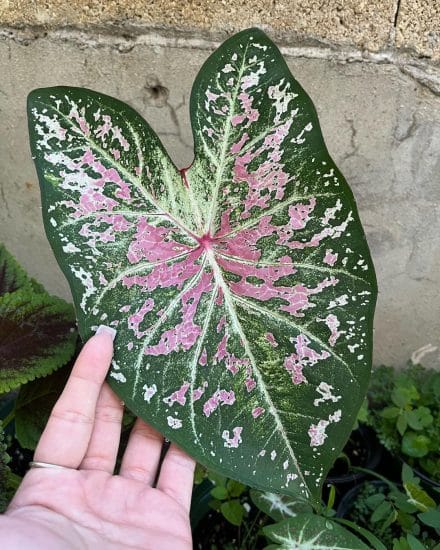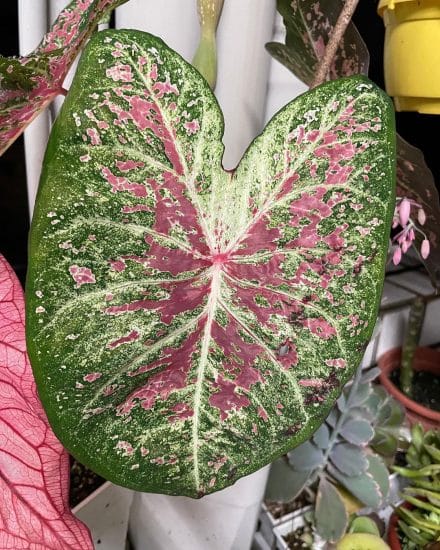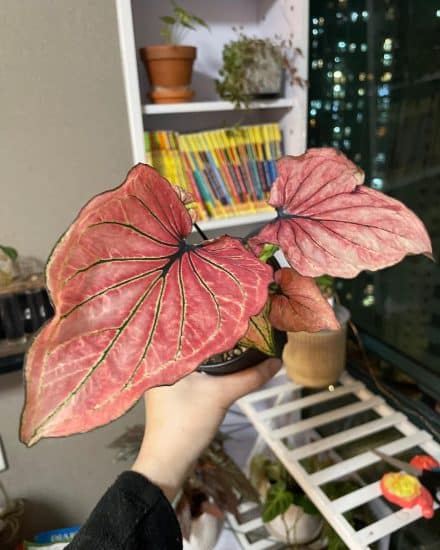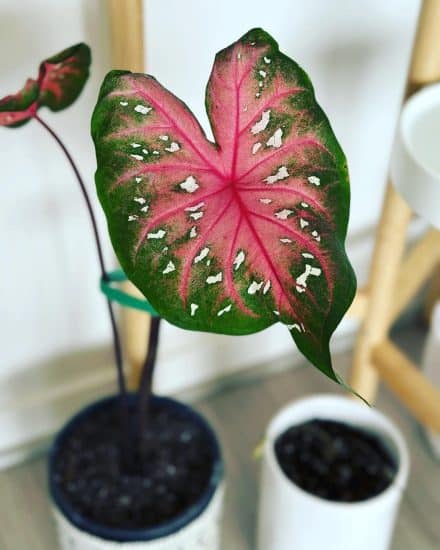You’re strolling through a lush, tropical rainforest, and your eyes are drawn to an explosion of color amidst the greenery . . . you’ve stumbled upon none other than the captivating Caladium!
(At least it’s not a poisonous snake.)
Spotting the caladium plant is kind of like looking through a kaleidoscope. Think striking, heart-shaped leaves that boast a profusion of bold reds, vibrant greens, crisp whites, and even mysterious purples (depending on the variety).
In this comprehensive guide, we’ll take you on a journey through the world of caladium care. You’ll learn how to replicate that tropical rainforest vibe in your home and let your caladium thrive.
Let’s go!
Table of Contents
Caladium Plant Care Guide
History, habitat, and characteristics

You might’ve seen caladium plants around, with their super vibrant and eye-catching foliage. You know, those plants with the huge, heart-shaped leaves that make you think, “Gosh, how pretty!”
Also called angel wings, these beauties come all the way from the tropical rainforests of Central and South America, mostly in the north, where they love soaking up the warm, moist vibes under the protective canopy of larger trees. When they were brought to Europe in the late 1700s, people began cultivating them immediately.
Do you like your foliage plants in eye-popping reds, greens, whites, or even purples? No problem, caladiums have got you covered!
Their leaf patterns vary, too – swirls, spots, and everything in between. As Adria Allen Aldrich put it in the New York Times way back in 1955, “[T]he caladium varieties have leaves that are speckled, blotched, crinkled and veined in interesting contrasts as gay as tropical birds.”
Fancy leaf or strap leaf caladium?
There are two main kinds of caladium, fancy leaf caladium (the ones you’ll see most) and strap leaf or lance leaf. Nicknamed the “Heart of Jesus” and derived mainly from C. bicolor, fancy leaf caladium has long petioles (like stems) supporting large heart-shaped leaves that can reach as long as a foot! The petioles themselves can reach up to 2.5 feet.
Lance or strap leaf varieties have arrow-shaped, narrower leaves with ruffled edges that are smaller than C. bicolor‘s. They’re nicknamed “elephant ears” (not to be mixed up with xanthosoma, colocasia, and alocasia, which people also call . . . that). This type has shorter petioles, grows bushier, and tolerates cold better than fancy leaf caladiums.
Did you know: Almost all caladium cultivars come from Caladium bicolor, also known as Caladium x hortulanum. C. bicolor has over 1,000 cultivars and growing (and that’s just the ones that are named!)
Caladium species

There are countless gorgeous caladium varieties to choose from and more being produced all the time! Let’s take a look at some popular ones and their stunning appearances:
- Caladium ‘Miss Muffet’: Features lime green leaves adorned with bright mauve freckles.
- Caladium ‘White Queen’: This striking variety has frosty white leaves with green edges and contrasting red veins.
- Caladium ‘Florida Sweetheart’: Brilliant pink leaves with green veins, edged by green borders
- Caladium ‘Red Flash’: Deep green leaves with red centers and veins speckled with pink dots.
- Caladium ‘Freida Hemple’: Most dominant among the red fancy-leaved cultivars, with frilly bright green edges and dark red centers.
Fun fact: Caladium growers in Florida supply all caladium tubers used not only across almost every continental US state, but also in 40 countries around the globe.
Now, you might be thinking, “But can I grow these tropical wonders at home?” Absolutely! They adapt just fine to life as indoor caladium plants from early spring to autumn. And if you live in warmer climates, they’ll love hanging out in your garden, patio, or walkway.
Just be careful, though – these lovely plants are actually toxic if eaten (keep them away from kids and pets, please!).
Light

Wondering how to replicate that lush, tropical rainforest vibe for your caladium? Well, let’s talk lighting!
Your new caladium buddy thrives in medium to bright but indirect light. But watch out for direct sunlight — those delicate leaves can burn.
On the other hand, a bit more (indirect!) light can bring out their vibrant colors.
But how do you know if your caladium is getting enough light or, heaven forbid, too much sun? Here are some telltale signs:
Not enough light: Are your caladium’s leaves losing their vibrancy? Does new leaf growth appear less colorful or patterned? If so, your plant might be craving more light. Oh, and watch out for “leggy” growth — those long stems reaching out for light, or etiolating.
Too much light: On the flip side, if your caladium is basking in harsh sunlight, it might get sunburned! Faded colors, brown or yellow spots, and crispy leaf edges are all red flags.
Water

Caladiums have some specific watering needs depending on the time of year. Since they go through a winter dormancy period, they don’t need water until you’re ready to revive them in spring.
Before those lovely leaves start sprouting in warmer weather, it’s best to keep the soil dry. That way, you won’t have to worry about any nasty rot setting in with your caladium bulbs.
Now, once those leaves begin to grow during the growing season, it’s time to crank up the watering. You’ll want to water your caladium when the soil is dry one or two inches down.
If the weather’s hot and sunny, you might need to water it daily or even twice a day (but be careful not to overdo it, as those roots need some oxygen too!). Keep the soil evenly moist, especially during the growing season.

Too little water can cause your caladium’s leaves to droop, and nobody wants that! If you see this happening, give your plant a friendly pep talk and promise to water it a bit more often during the active growing season.
Too much water isn’t great either. Remember, caladium roots need oxygen, so you don’t want to drown them. Keep a close eye on your plant and adjust your watering routine as needed during the growing season.
To make sure you’re striking the right balance, give the soil a little poke before watering. If it feels moist or heavy about two inches down, hold off and give it a chance to dry out a bit more. Trust us, it’s better to play it safe and underwater than risk turning your precious caladium into a swamp monster.
Temperature and humidity

As Caladiums are tropical foliage plants they thrive in warm, humid environments. Let’s take a closer look at the ideal temperature and humidity levels for your caladium.
During the day, caladiums prefer temperatures between 70-85°F (21-29°C), which is especially important in the growing season. At night, we recommend a slight drop in temperature to around 60-65°F (15-18°C).
To ensure your indoor Caladium stays happy, keep it away from cold drafts, like open windows or air conditioning vents, and from direct heat sources like radiators that could make the environment too warm.
When it comes to humidity, caladiums love a moist atmosphere, so you’ll want to maintain at least 50% humidity in your home for these shade-loving plants.
If you notice your caladium’s leaves starting to curl, wilt, or develop brown tips, it might be a sign that the humidity is too low. On the other hand, yellowing leaves or mold growth can indicate too much humidity.
Caladium humidity tips:
- Place a tray of water and pebbles beneath the plant, which will release moisture as the water evaporates.
- Use a humidifier near your caladium.
- Don’t rely on misting the leaves, since this isn’t a long-term solution, but you can wipe down your plant’s leaves with a damp cloth to get rid of dust and prevent bugs.
Soil and planting

Caladiums love well-draining, chunky, rich soil that lets air reach their bulbs while still retaining moisture.
With this in mind, we recommend a forest floor potting mix for your caladium. It hits that balance between moisture draining and retentive, and bonus, it contains lots of things to mimic your plant’s home closer to the forest floor in nature, like worm castings.
You can also use a general potting soil mix with a few amendments to keep it chunky and free-flowing, like perlite and coco coir.
The wrong potting mix can lead to waterlogged roots, making it difficult for your plant to take in the necessary oxygen and nutrients it needs to thrive. If you notice yellowing leaves, slow growth, or roots that aren’t firmly anchored, these could be signs that your potting mix isn’t providing proper support and nutrients.

When you notice roots emerging from the drainage holes or wrapping around the pot’s interior, it’s time to repot your caladium.
When pruning snip off any brown or dead leaves you see. If you’re prepping the bulb for winter storage, though (see the “Propagation” section below), dig it up first and only then chop off all remaining foliage. It’s best to begin propagation when soil temperatures start getting above 65°F.
Fertilizing
Caladiums benefit from more fertilizer than other shade-loving plants because they use more water and sunlight. Fertilize twice a month with half-diluted fertilizer.
Overfertilizing? You’ll see leaf burn and wilting. To resolve the issue, flush the soil with water to remove excess salts and nutrients. Allow the pot to drain completely and reduce the frequency or strength of your fertilizer applications.
Propagation

Ready to get your hands a little dirty and propagate some gorgeous caladiums? Just follow these steps, and you’ll have more fabulous caladium varieties in no time (and maybe even invent some of your own!).
Note: In fall, your caladium’s leaves will die back, which is totally normal. If you’ve been growing them outside, let the soil dry, then remove the tubers from the ground.
If you’ve been growing them inside (like me!), you can keep the caladium bulbs in their pots, put them in a box, then store them in a dark cool place (about 55° F) like a basement.
Propagating caladium plants by tuber division:
- Say hello to the tuber: When spring arrives and temperatures are ideal, gently take your caladium out of its pot and find the main tuber, or “bulb.” You should see some cute little “pups” growing from it.Here you have two choices: you can cut off a pup with a sterilized knife or shears; or make a neat cut between two eyes on the caladium bulbs (like you’d cut a potato), making sure each piece has at least one eye.
- Charcoal to the rescue: Next, spread some activated charcoal powder on the fresh cuts. This powder will keep infections and rot away so your caladiums can thrive like champions.
- Give them time to chill: Before you plant these tubers, let them callus for a few days in a dry and airy spot. This helps the cut surfaces toughen up and heal, which means no rot or disease when they hit the soil.
- Get those tubers in the soil: Once the caladium bulbs are callused and ready to roll, plant them in fresh potting soil with the eyes up, making sure each piece is covered. Give them a good drink, but don’t drown them – just moist soil, not soggy.
- Watch them grow: Now, find a cozy, shady spot with indirect bright light and high humidity for your new caladium babies. Keep the soil evenly moist and have patience while they grow.
And that’s it! Now go propagate those beautiful plants and enjoy your stunning caladium collection!
Common Issues

Caladiums certainly are beautiful plants, but they can run into a few issues along the way. Let’s chat about the top three problems you might face and what you can do about them.
Leaves dying off
So, you’ve noticed your Caladium is losing some leaves? Don’t worry, it’s totally natural for older leaves to die back as the plant shifts its focus to new growth. But hey, if it seems like too many at once, let’s look at some possible causes.
You’ll want to snip off any flowers that pop up — they can be real energy-drainers for the plant.
Noticing burnt or crispy leaves as well? Oops! It might be a result of too much fertilizer. Just dial back on the amount you’re using and watch your plant bounce back.
Oh, and don’t forget about temperature! As a tropical plant, caladiums aren’t fans of cold drafts or very low temps, so keep them cozy to prevent leaf loss. Leaf drop paired with light green leaves could be a sign that your caladium needs more nutrients.
Leggy growth
Has your caladium gotten a bit leggy? It likely just needs more light! When this happens, the plant gets all stretchy, reaching for more sunlight, which leads to longer stems and sparse foliage.
So, move your plant buddy to a spot with brighter, indirect sunlight. Just remember, too much direct full sun is a no-go, as it can scorch those delicate leaves.
Wait, could it be a lack of nutrients? That’s possible, too! Providing the right fertilizer in the appropriate amounts is like dishing up a perfectly balanced meal for your caladium. So, make sure you’re feeding your plant correctly to promote healthy, bushier growth (and avoid those spindly stems!).
Yellow leaves
This might be due to overwatering or overly wet soil. Allow the soil to become almost completely dry before watering again, and use a well-draining soil mix to help retain moisture without causing root rot.
Pests and diseases

Let’s talk about the two common problems you might encounter with your caladium: mealybugs and root rot. We’ll go through how to identify these problems, fix them, and make sure they don’t come back to haunt your beloved plant.
Mealybugs

First up, those pesky mealybugs! They look like tiny, white cotton masses that love to hang out on leaves, stems, and sometimes even in the potting mix (sneaky little things!). They’re not just here for a good time, though — they feed on your caladium’s sap, which can lead to stunted growth and unhappy, discolored leaves.
Solution: Start by isolating your caladium from other plants to prevent spread. Gently remove bugs from leaves and stems with a soft brush or damp cloth. If you’ve got a stubborn infestation and the leaves start to die back, it’s time to bring out the big guns: a water and dish soap mix, or neem oil. Just follow the directions on the label, and your caladium should be bug-free in no time.
The key to prevention? Good plant hygiene! Make sure to keep your caladium’s leaves clean and watch out for unwanted visitors. Oh, and don’t forget to use well-draining potting mix (your plant will thank you!).
Root Rot
Now let’s chat about root rot — another issue that our lovely caladiums can face, mainly due to overwatering or poor drainage. If your plant’s leaves are looking yellow and wilted, and there’s an unpleasant smell coming from the soil, you might have a case of root rot on your hands.
Solution: Remove your caladium from its pot and check out those roots. If you see any slimy, mushy, or dark roots, give them a snip using sterilized shears. After that, it’s time to repot your plant with fresh, well-draining soil — think perlite, pumice, or LECA (your caladium will appreciate the added aeration and drainage).
To keep root rot at bay, keep an eye on your watering habits. Let the topsoil dry out a bit before giving your caladium a drink, and always make sure to let any cachepots or saucers drain.
Conclusion

Whether they’ve got green margins and dark red centers like ‘Freida Hemple’ or lighter green leaves with cute pink freckles like ‘Miss Muffet,’ these striking plants will grab your attention and keep it. And there are so many caladium to choose from . . . it’s like being a kid in a candy shop!
We hope our caladium plant care guide helps you keep your plants looking stunning. If you have any questions, don’t hesitate to reach out to us. And please, show us your gorgeous caladium plants so we can admire them too!
Take care!
FAQ
How do you take care of potted caladiums?
Pottered caladium prefer bright indirect light, even soil moisture and a well-draining soil mix, temperatures between 70-85°F, and humidity above 50%. That’s it!
Do caladiums come back every year?
Yes, caladiums can come back every year, especially if you live in a warm climate. However, they do go dormant during the winter months, which means their leaves will die back. Don’t worry, though! If you’ve overwintered them properly (see our “Propagation” section), as temperatures warm up and spring arrives, your caladium will awaken from its winter slumber!
Can you keep caladiums indoors all year?
Absolutely! Caladiums make perfect indoor plants. Just keep those humidity levels high and give them bright indirect light and warm temps. Caladiums will still go dormant during winter, but with proper care, they’ll come back to life in spring, making them a fantastic indoor plant option.
Do caladiums do better indoors or outdoors?
It’s a tie — honestly! Caladium indoor care is easy, and they brighten up any space with their vibrant foliage (especially good for those who live in a colder climate). Outdoors, they prefer warm, humid climates and partial shade locations, as direct sunlight can damage their leaves.


